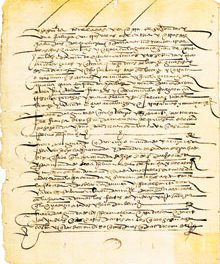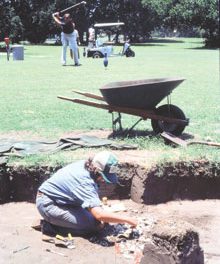At stake was the answer to one question: Was Parris Island the site, or one of the sites, where America began?
Nothing happened between 1940 and 1957. Then, in 1957, a highly respected U.S. Park Service historian from Florida, Mr. Albert Manucy, went to Parris Island to review the pottery that had been discovered at “Charlesfort.” Manucy was very knowledgeable in 16th century European pottery, and he came to one conclusion. The pottery that was discovered by Major Osterhout in the 1920’s was not French. It was Spanish. The immediate implication? Parris Island had a Spanish fort on it. And it just might be the long lost capital of La Florida, Santa Elena.
Manucy’s strong suspicion that Parris Island might be the home of Santa Elena did not take root until 1976, when two different forces came together. Dr. Eugene Lyon dug behind the documented history of Santa Elena and published the book The Enterprise of Florida. In it, for the first time, the story behind Santa Elena begins to be uncovered. He provides answers to key questions. For instance, why did Spain want to target Port Royal Sound as its starting point for expansion? He introduces the first governor, Pedro Menendez de Aviles, who appears to be more than a real life John Wayne. Dr. Lyon then reveals the strategy of the Spanish crown – to protect the return of the Treasure Fleet, build an inland road to Mexico from Port Royal Sound, use Santa Elena as the hub for finding the inland waterway to China. Thanks to Dr. Lyon’s book, the incredible story behind Santa Elena begins to take shape. But remember, at this point, the evolving story is only known by a handful of specialized historians.
Dr. Lyon’s work stimulates the curiosity at National Geographic Magazine. In 1978 Joe Judge, the Associate Editor of the magazine, decides to dig behind Gene Lyon’s work. He first calls Dr. Paul Hoffman, distinguished professor of Colonial History at LSU. He asks Dr. Hoffman to review 16th century documents and summarize the colonial Spanish forts that might be on Parris Island. Dr. Hoffman gave Joe Judge this report:
Spanish forts believed to be on Parris Island
- 1566: Fort San Salvador
- 1566-1570: Fort San Filipe I
- 1570-1576: Fort San Filipe II
- 1577-1582: Fort San Marcos I
- 1583-1586: Fort San Marcos II
- 1586-1587: Fort San Marcos III
The National Geographic smells an important and unknown story. With the help of Dr. Lyon, Joe Judge organizes a meeting of the nation’s few top 16th century historians and archaeologists. The plan is to take these experts to the fort that Major Osterhout had labeled ”French” and try to determine if it is French or Spanish. If the fort is deemed French, it will mean that it’s Ribault’s Charlesfort. If it is Spanish, it may mean that it is Santa Elena . . . the long lost capital of Spain’s first colony. This distinguished group included Joe Judge from the National Geographic, Dr. Eugene Lyon, Dr. Paul Hoffman from LSU, Bob Stephenson, Director of South Carolina’s Institute of Archaeology and Anthropology, and Stan South, one of Bob’s archaeologists. It did not take this group long to reach a conclusion: This is a Spanish fort, most likely Fort San Marcos. Santa Elena may be here . . . on Parris Island.
My thanks to three of the Santa Elena Foundation’s most important 16th century historians – Dr. Eugene Lyon, Dr. Paul Hoffman, and Dr. Chester DePratter.
In the next issue: Is the long lost capital of Europe’s first colony located on Parris Island?








